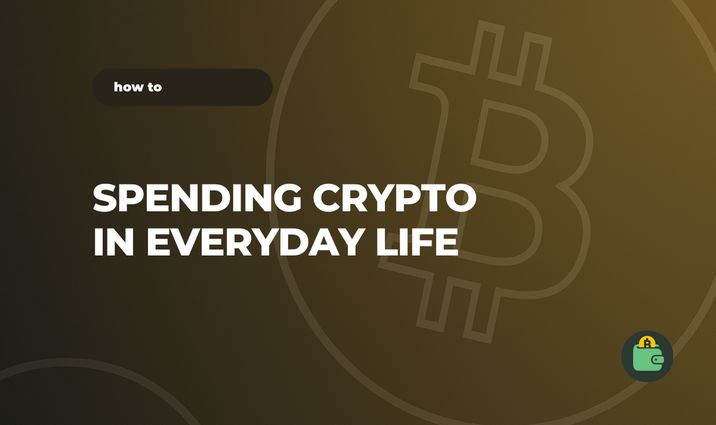Spending Crypto in Everyday Life: How It Works in the USA and Europe

Someday, we will all use crypto in our daily lives to pay for rent, groceries, and maybe even a bus ticket. But that day hasn't come yet, and we’ve mostly had to use fiat money. Nevertheless, there are a few ways to pay with crypto in everyday life.
First, some statistics on how many people own and use crypto in their daily lives.
In the USA and Europe, numbers are different from each other because they are related to social, political, and economic factors. So in 2024, 40% of U.S. adults own cryptocurrency — 93 million people. In Europe, the figure is about 49.2 million people. Obviously, this difference might be explained by crypto freedoms that are more widespread in America than in Europe. However, this doesn’t stop Europeans from spending crypto. And in this article, we'll discover places where you can spend it too.
Key Takeaways
- Crypto is accepted indirectly via third-party services like BitPay or Bitrefill in both the USA and Europe.
- Crypto debit cards make everyday spending possible, converting crypto to fiat at the moment of purchase.
- Crypto-friendliness varies by region, with some U.S. states and European cities actively supporting crypto payments.
How to Pay with Crypto in America
In the United States, a few chains let customers pay with Bitcoin or other cryptocurrencies, often via third-party apps. Here are several ways.
Way 1. Companies that already accept crypto payments
Paying with crypto in physical stores is still limited, but many online and offline platforms allow you to buy goods and services with crypto.
For example, you can pay for a Microsoft account using BTC, BCH, ETH, USDC, and more, but only through BitPay or Bitrefill, not directly. The same goes for one of the largest hardware store chains in the U.S., Home Depot. Whole Foods and many merchants partnered with Flexa or BitPay and also accept crypto checkout.
Here's a more detailed list — for each company below, you’ll find how to pay (directly or via a third party).
🛒 Retail & E-Commerce
- Newegg: Pay directly via BitPay with Bitcoin, Ethereum, Litecoin, Dogecoin, and more.
- Overstock: Pay directly via BitPay using Bitcoin only.
- Amazon, Apple, Walmart, Best Buy, Target, etc.: Buy gift cards with crypto via Bitrefill.
🍔 Food & Delivery
- Domino’s Pizza, DoorDash, Uber Eats, Instacart, Starbucks: Buy gift cards on Bitrefill.
✈️ Travel & Transportation
- Travala: Pay directly with crypto on Travala.com.
- airBaltic: Pay with Bitcoin via BitPay.
- Destinia: Pay directly with crypto on Destinia.com.
💻 Digital & Tech Services
- Namecheap: Pay with Bitcoin on the website.
- ExpressVPN: Pay with crypto on the website.
- NordVPN: Pay directly with Bitcoin on the website.
🎮 Entertainment & Subscriptions
- Netflix, Spotify, Steam, Google Play: Buy gift cards on Bitrefill.
- Twitch: Send crypto donations directly to streamers who support it.
Way 2. Using a Crypto Debit Card
However, most retailers don't list crypto among accepted payment options. Instead, many American users rely on crypto debit cards to spend crypto anywhere Visa or Mastercard are accepted.
For example, a Bitcoin debit card converts the crypto in the wallet into legal tender that the business accepts. According to Investopedia’s rankings, Coinbase, Crypto.com, Wirex, and ByBit offer the best options.
In effect, the card “sells” a bit of crypto for dollars or euros whenever you swipe it, so you can use it at any merchant that accepts cards. For example, the Coinbase Card (Visa) is free in the U.S. (2.49% crypto-to-fiat fee). U.S. residents can get a Coinbase debit card for free, while European residents will need to pay a small issuance fee.
Meanwhile, Crypto.com’s Visa card is widely used in Europe for its cashback rewards.
You can also use the Moon service. It lets you create a virtual Visa card to shop online.
Most crypto wallets and exchanges let you link a debit card or bank account to buy crypto. This is done through built-in “Buy Crypto” features. For example, Coin Wallet lets you add a Visa or Mastercard or use Apple Pay or Google Pay to buy crypto instantly.
Way 3. Paying Taxes with Crypto
No U.S. state outright bans crypto payments, and some states even allow paying taxes in crypto (Colorado, Utah, and Louisiana are the only states that let taxpayers use Bitcoin for state fees).
States like Wyoming and Florida have passed particularly crypto-friendly laws, including removing the transmission license requirement for exchanges and launching pilot crypto payment programs, while New York and California continue to impose stricter regulations.
How to Pay with Crypto in Europe
Across Europe, the situation is similar. European merchants can install crypto payment plugins on their websites. For example, Shopify-based EU stores often offer BitPay or Coinbase Commerce as payment options. Travel platforms like Travala and others operate globally. But there is a nuance.
In Europe, cryptocurrencies are not legal tender (only the euro is), so shops aren’t required to accept them. Still, some retailers and restaurants — especially in crypto-friendly cities like Berlin and Zug — do take crypto. Larger retailers in Europe can integrate payment gateways (BitPay, Coinbase Commerce) to accept Bitcoin. For instance, some Italian cafés display “Bitcoin OK” signs.
Like in the USA, crypto debit cards are widely used in Europe to spend crypto at any store that takes cards. The ByBit debit card is currently one of the most popular options. You just need to convert crypto to fiat and pay with a virtual card.
The Bottom Line
While cryptocurrencies are not yet a mainstream method of payment, there are already many ways to use them in everyday life — from buying products to paying taxes. In both the USA and Europe, crypto adoption is growing, supported by favorable regulation in some regions. The transition to daily crypto use is slow but steady, opening new opportunities for consumers and businesses alike.